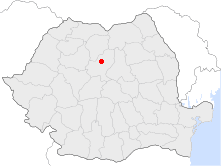| Revision as of 17:45, 22 December 2007 editRoamataa (talk | contribs)2,817 editsNo edit summary← Previous edit | Revision as of 08:13, 24 December 2007 edit undoPEHowland (talk | contribs)Extended confirmed users1,300 editsm →PeopleNext edit → | ||
| Line 78: | Line 78: | ||
| * ] (b.1925), Painter | * ] (b.1925), Painter | ||
| *] (1756–1821), Writer and Educator | *] (1756–1821), Writer and Educator | ||
| * ], luthier and successful businessman | |||
| == Images == | == Images == | ||
Revision as of 08:13, 24 December 2007
Municipality in Mureş County, Romania| Reghin | |
|---|---|
| Municipality | |
 Location of Reghin Location of Reghin | |
| Country | |
| County | Mureş County |
| Status | Municipality |
| Government | |
| • Mayor | Nagy András (Democratic Union of Hungarians in Romania) |
| Area | |
| • Total | 56.09 km (21.66 sq mi) |
| Population | |
| • Total | 36,173 |
| Time zone | UTC+2 (EET) |
| • Summer (DST) | UTC+3 (EEST) |
| Website | http://www.primariareghin.ro/ |
Reghin (German: (Sächsisch) Regen; Hungarian: Szászrégen or Régen) is a city and municipality in Mureş county in Romania, on the Mureş River in Transylvania. It is the place of origin for the Sasregen Hasidic Jewish dynasty. It has a population of approximately 35,700 in 2004.
Location
Reghin lies 29km north-northeast of Târgu Mureş, extending on both shores of the Mureş River, at the confluence with the Gurghiu River. It was created by the 1926 union of the German-inhabited and the Hungarian-inhabited city, and later joined with the two smaller communities Apalina (Hungarian: Abafája; German: Bendorf) and Iernuţeni (Hungarian: Radnótfája; German: Etschdorf), added in 1956.
History
Reghin was first mentioned in 1228 in a charter of Hungarian King Andrew II as Regun - however, evidence of its strategic location and defence system suggests that the town might have been considerably older, possibly founded during by Ladislaus I.
Despite of the devastations of the city during the Mongol invasion (1241) and during the Tatar and Cuman incursions (1285), the town developed rapidly: already in the second half of the 13th century the city is the residence and power centre of the families Tomaj and Kacsik, to whom the nearby lands were awarded by the Hungarian Crown. Reghin became a minor ecclesial centre in 1330, with the building of the Gothic church (Roman Catholic at the time, it now serves the Protestant community) in the German part of the city; it is still the largest church in the area, and hosts the oldest Medieval Latin inscription of any church in Transylvania. The Hungarian part of the city has an even older church, initially built in the Romanesque style.
In the beginning of the 15th century the settlement gained city rights, and, from 1427, the right to hold fairs. In the 16th and 17th century Reghin was devastated by Habsburg and Ottoman troops on several occasions. It burned to the ground in 1848. In 1910, the population of the city included 7,310 inhabitants, of which 2,994 Germans (Transylvanian Saxons), 2,947 Hungarians, and 1,311 Romanians.
In 1920 Reghin, was assigned to Romania by the Treaty of Trianon, together with the rest of Transylvania. During the 20th century, the city has completely lost its former Transylvanian Saxon character - as many Germans left for Western Germany during the latter stages of Communist Romania - and ethnic Romanians were settled in their place. Almost 30% of the inhabitants until 1939 were Jews. In May 1944, the Jews were gathered in the ghetto of Reghin and on June 4, 1944 were deported to Auschwitz. The data of the 1992 census showed a population of 24,601 Romanians, 12,471 Hungarian, 1,790 Roma, and 346 Germans.
Demographics
- Romanians = 23,611 (65.35%)
- Hungarians = 10,396 (28.77%)
- Roma = 1,831 (5.06%)
- Germans = 237 (0.65%)
- others.
Landmarks
The traditionally German city:
- the Protestant (Lutheran) church, built in 1330 in honour of Saint Mary. Burnt down in 1708 and in 1848, after which it had been rebuilt.
- the Roman Catholic church, which was consecrated in 1781. A Calvinist church was built in 1890.
- the Greek-Catholic church, built between 1811 and 1813, nowadays Romanian Orthodox.
The traditionally Hungarian city:
- the Protestant (Calvinist) church, 13th century, in 1910 completely rebuilt.
- the Greek-Catholic church, built in 1744, nowadays Romanian Orthodox.
New landmarks:
- a Romanian Orthodox Cathedral was built in the city in the 1990s.
- the renowned zoological and folklore collections.
People
- Sergiu Ionut Nistor (1987–present), The last sheepherder
- Josef Haltrich (1822–1886), ethnographer, historian.
- Ferenc Kós (b. 1828), writer
- Rudolf Wagner-Régeny (1903–1969), composer
- Georg Maurer (19071971), writer
- Jutta Pallos-Schönauer (b.1925), Painter
- Petru Maior (1756–1821), Writer and Educator
- Vasile Gliga, luthier and successful businessman


